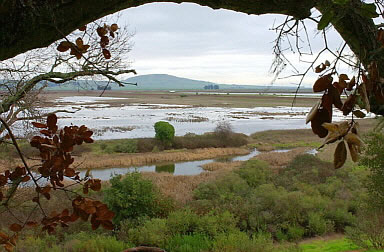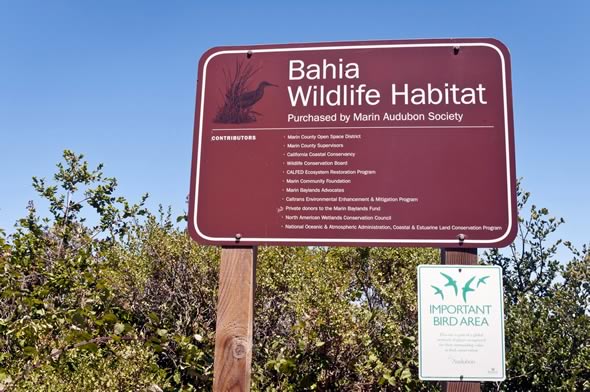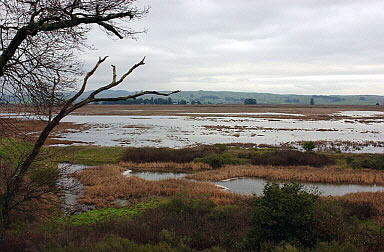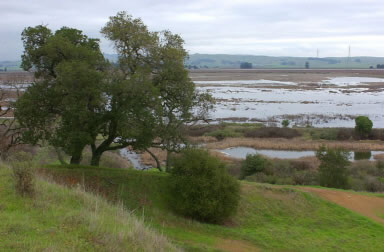
Bahia Wetlands
Bahia Wetlands at Three Years of Restoration
A film on resident wildlife and Marin Audubon’s habitat restoration work underway at Bahia Marsh, on the Petaluma River in Novato, California. Produced by Jeffery Martin as a gift to Marin Audubon.
This YouTube film was shot in Full High Definition. For the sharpest picture, click the Highest Quality option on your device for YouTube playback.
Saving Bahia’s Endangered Ridgway’s Rails
Note: The Ridgway’s Rail was formerly known as the California Clapper Rail.
Bahia Marsh bouncing back – MarinScope Newspapers, July 29, 2008

September 2007 Update
The US Fish and Wildlife Service finally issued the Biological Opinion on the Bahia Marsh Restoration project in August. Its recommendations are extensive. We will not only have to abide by the “Clapper Rail window” which allows construction in tidal marsh only during the non-breeding season (September 1 through January 31), but the report also includes a number of other requirements, including having a biologist survey for Clapper Rails during construction adjacent to the marsh during the non-breeding sea-son, publishing a fact sheet for construction workers informing them of Rail impacts, prohibiting dogs, cats, and litter at the construction site.
Most agencies are trying to move along our application for marsh restoration project so we can begin construction. We expect to Have most permits by the beginning of October. However, the Homeowners Association has had our latest draft language for an access easement in their possession for nearly four months, and have not yet given us their comments.
On another front, the Marin County Open Space District has begun work on a new trail to direct people uphill, away from the edge of the marsh. We commented on the environmental documents and reviewed the alignment of the trail, which seemed to avoid trees. We have urged the county to obliterate the existing trail when the new one is completed. This would avoid multiple impacts of the use of two trails.

February 2007 Update
Unfortunately, during the Novato Planning Commission hearing for MAS’s restoration project, Bahia homeowners made numerous statements that were based on misinformation. The stage may have been set by an article in the HOA newsletter which contained a number of erroneous statements about our project. The most sweeping error was that Marin Audubon intended to “exclude” access to the peninsulas on MAS property. The HOA consultants’ testimony also contained errors, such as MAS planned to place dredged material over the lands where the HOA would have had to make the cut through our western peninsula. A difficult situation was made worse when the Planning Commission allowed personal attacks throughout the hearing and did not stop rambling testimony on matters unrelated to the property in their jurisdiction. This distracted from the homeowners’ relevant concerns, such as the movement of some of the excavated material through the streets.
MAS’s property — 55 acres containing three peninsulas surrounding the HOA lagoon – were formed more than 30 years ago for houses. At no time has there been anything stated or written to indicate that it is, or has been, our intent to exclude access.
Our project was part of the overall project reviewed by the DFG-certified EIR that was available for review on the San Francisco Bay Joint Venture Web site. In fact, many comment letters were submitted to DFG, and the EIR consultants responded to each comment letter. Many of these letters were from Bahia residents.
Following our restoration project, people will be able to access our property as they do now, with the exception of the 20 acres that will be restored to marsh. To restore the 20 acres of marsh, fill material placed on tidal marsh many years ago will be excavated and moved to other areas to be vegetated with native transitional and upland plants. Currently, our property is largely vegetated with non- native species.
There will be no change to a 75-foot-wide strip along the lagoon underneath the PG&E towers where people now fish and walk. Some will be trucked to Fish and Game lands to elevate subsided lands and speed the restoration of the tidal marsh.
We plan to meet with the homeowners to clarify what our project is and, hopefully, gain the support of some residents. Those who want the lock/dredge project may always be hostile.
On another front, Marin Audubon is cooperating with the city of Novato and DFG to address the strong sulfide odor coming from the far western section of West Bahia. The odor is due to decaying vegetation trapped in low layers of the ponded water. DFG is using a biological agent and will cut notches in the perimeter levee to allow increased tidal flows. As part of our project, tide gates will be installed to better control the water levels and increase circulation. It is essential our restoration project be accomplished this summer to avoid the worst time of year for plant decomposition, which is late summer.
Finally, a huge thank you to The Forrest and Frances Lattner Foundation for their grant of $24,000 for replanting the high tide refuge/transition zone habitat on MAS property at Bahia. This grant funds planting of native plant species along the marsh edge to provide cover, nesting and foraging habitat — important components of tidal marsh and uplands habitat.
HOW YOU CAN HELP: Write the Novato Community Development Agency, 75 Rowland Way, #200, Novato, CA 94942 in support of our wetland restoration project or attend the Novato Planning Commission meeting on Monday, December 18 at 7:30 P.M at the Novato Unified School District Offices (pdf agenda). If you would like more information, please call Barbara Salzman, 924-6057 or email .
January 2007 Bahia Update
Great news! On December 28, Judge Michael Dufficy vacated the court order requiring the Bahia Homeowners Association (HOA) to provide boat access to the Petaluma River. The project would have dredged and permanently converted some 13 acres of tidal marsh that is habitat for the endangered California Clapper Rail.
After hearing more than three hours of testimony, Judge Dufficy determined that circumstances had changed dramatically since the original court order so as to render the project infeasible. He listed a number of changed circumstances, including: conflicts with existing Bay Conservation and Development Commission (BCDC) policies and law; new laws and policies of agencies making permitting much more difficult if not impossible (the recent State Endangered Species Act prohibits the Department of Fish and Game (DFG) from issuing permits to take a fully protected species, which the Clapper Rail is); different ownership of adjacent lands (owned by MAS) which limits access; additional requirements by the city of Novato; uncertainty about whether the project could ever be built, even if the homeowners could obtain permits, it would be more than 20 years before homeowners would know whether the mitigation requirements could be fulfilled; and substantially increased project costs (now estimated to be more than $17 million).
The HOA, represented by attorney, Wanden Traynor, presented three witnesses: Michael Wilmar former executive director of the BCDC, Cay Goude, head of the U.S. Fish and Wildlife Service Office of Endangered Species, and Michael Josselyn, of the HOA consultants WRA. The opposing side, represented by attorney Michael Kane, presented declarations from John Zentner, Michael Cheney, and John Knox that were not made public. They presented no witnesses. Their other attorney, Gary Raggianti, had dropped the case and so was not present.
This was a significant milestone for Marin Audubon Society because we have long opposed the loss of tidal marsh for a recreational boating and, in particular, the loss of endangered species habitat by dredging the HOA’s tidal lagoon. Our attorney, Clem Shute, provided important support for the testimony, particularly with regard to BCDC.
December 2006 – Bahia Lagoon Dredge Update (from MAS newsletter)
The court hearing for the Bahia Homeowners Association’s appeal to vacate the order to provide boat access to the Petaluma River is scheduled for Thursday, December 28, probably in the morning, but you will need to check closer to the date.
Initially, Judge Dufficy stated he intended to deny the HOA’s appeal. At the last hearing, however, he modified his approach and allowed that each side could present three witnesses at an evidentiary hearing. He acknowledged that he knows little about the permit process for filling wetlands and endangered species habitat, and construction for the boat access would place a significant financial burden on residents. This is an important change in his approach.
MAS’ attorneys, Clem Shute and Tamara Gallanter, from Shute Mihaly and Weinberger, have submitted two Friend of the Court briefs and are appearing in court on our behalf in support of the HOA’s motion to vacate the order. Our legal bills for this effort are significant. Fortunately, a generous anonymous donor has helped, but we still need donations.
July 2006 – Bahia Lagoon Dredge Update:
Bahia HOA goes to court to get dredge/lock order thrown out – Novato Advance, 7/12/06
June 2006 – Property Update:
The Draft Environmental Impact Report for the Bahia Marsh Restoration Project has been out for public review, and the comment period closed on May 20. We expect that comments will be responded to and look forward to a final approval in late June or early July so that we can proceed with the restoration construction.
April 2006 – Property Update:
The DEIR has just been released and can be found on the San Francisco Bay Joint Venture web site for those who want to read it. The review period will be 30 days after which we hope to move forward quickly with permitting. If all goes well we will be able to begin construction this summer or fall.
January 2006 – TIDES TURN AT BAHIA
Opinions are changing at Bahia, as reflected in responses to a recent survey of the 288 Bahia homeowners. Of the 240 respondents, 164 or 68%, were opposed to the lock-dredge project and opposed paying the assessment ($45,000 for off-water and $90,000 for on-water residents) needed to complete the project; 176 or 73%, indicated this cost would cause financial hardship; 41% indicated they were willing to pay nothing, and 25% were willing to pay a very minimal amount (between $1 and $100) for monthly maintenance of the lagoon. Maintenance is an important issue because there is a real potential for water quality problems with the design. There are areas where water would stagnate and drop sediments because they would not flush well. The strong anti-project vote was likely influence by the recently updated construction cost estimate which identified the cost in the range of $17 million instead of the $8 million the receiver had touted for years. This figure does not even include costs of ongoing maintenance and management. Bel Marin Keys, that has a similar lagoon system, had to do expensive dredging after years of neglecting the maintenance flushing of their lagoon. They now have a manager to maintain their lagoon and reportedly have the highest taxes in the county.
Interestingly, 142 homeowners (59%) found the current condition of the lagoon, which is now restored to tidal marsh, acceptable and 169 or (71%) said they would not even use the lagoon for boating.
The reasons to revise the court decision are increasing. They are both biological and economic.
All signs now point to this as the time the Home Owners Association should go back to the court and request to be relieved of the order to provide boat access.
January 2005
GRANT NEWS – MAS is thrilled to announce receipt of a check in the amount of $37,445 from National Audubon Society to help fund a plan for the property (three peninsulas) that MAS owns at Bahia. This was a grant from The Orvis Company obtained for MAS by California Audubon’s San Francisco Bay Program about a year ago.
The grant funds went to NAS and, for some reason, NAS took more than six months to release them to us. Our thanks to Susan Lewis of the California Audubon staff for doggedly pursuing this on our behalf. We very much appreciate Orvis’ contribution and that of many of its customers who donated matching funds. These funds will be combined with funds received from the Forrest Lattner Foundation and the Marin Community Foundation to complete the plan.
MAS is also pleased to announce it has been approved for a grant from the Friends of the San Francisco Estuary in the amount of $1,300 to fund public outreach for the Bahia restoration project. Our thanks to the Estuary Project for this financial assistance.
History of Bahia
The existing Bahia development of 288 houses (80 on water) was built before the California Environmental Quality Act, so the very high siltation rate in this area was not disclosed. Removing the sediment to keep the channel open required unanticipated frequent dredging. A further complication was that, due to increasing public concern about the disposal of dredged material in the bay, regulatory requirements for testing and disposal of dredged material became more stringent and costly. This further hampered the HOA dredging. Finally, some of the residents sued to get the HOA to move ahead on dredging. A Marin County Judge agreed and appointed a receiver charged with pursuing a project that would provide boating access to the Petaluma River.
The boat access project has changed over the years. It originally involved dredging of the HOA tidal lagoon (surrounded by docks and houses) and channel, but this was later modified to include a lock, to reduce siltation in the lagoon and hence the need to dredge. Early on, these projects were combined with previous owner Condiotti’s Bahia development project. As the combined plan was unable to get permits, the lock/ dredge project was separated from the housing proposal and the design changed: the tidal lagoon would be dredged, a plug placed at the lagoon mouth to stop tidal action, a channel excavated through a peninsula (that MAS now owns) to connect the tidal with the non-tidal lagoon, and a lock constructed for boat access to the river. This project would still result in the loss of about 12-15 acres of tidal marsh that had been restored within the lagoon and channel since the last dredging in 1987.

Through about 15 years of project review, the court-appointed receiver and his attorney repeatedly promised that agency permits were just around the corner. However, the permits never materialized because the agencies had problems with the significant impacts of the project. Costs were mounting and there was no end in sight. Finally, Bahia citizens’ took matters into their own hands, went back to the court, got approval to reestablish a Board of Directors, and elected Board members.
Previous Updates
February 2004
A special thank you to the Forrest Lattner Foundation for approving a grant of $25,000 to assist in preparing a design for restoring the 60 acres MAS owns at Bahia. We have applied to several other possible funding sources for the additional funds necessary to complete the design plan. Planning for the 330+ acres now owned by the Department of Fish and Game is underway. We want to ensure that planning for the restoration of these sites is coordinated.
On the subject of the lock/dredge project, Judge Michael Dufficy held a second hearing on January 7, 2004. Dufficy allowed Marin Audubon to participate as a friend of the court and an interested adjacent property owner. We were ably represented by our attorney Clem Shute who spoke to our commitment to protect the Clapper Rail habitat and difficulties ahead because we will not permit use of our property for the environmentally damaging lock/dredge project except the limited use we are required to provide by agreement made by the previous land owner.
At the first hearing, many homeowners who attended objected to the receiver, Marshall Levy, and his excessive expenditure of money. The Homeowners Association now has a deficit of more than $300,000. In response to the request of many Bahia residents, Judge Dufficy directed that an election be held to reinstate a Board of Directors that will replace Marshall Levy as receiver of the Homeowners Association and that a special master be appointed to oversee the election. On the negative side, he allowed Marshall Levy to spend an additional $20,000 to $25,000 to pay Zentner and Zentner Associates to conduct surveys for the endangered Clapper Rail.
2003 – The HOA has a new attorney but has retained the same biological consultant, John Zentner, who is now the project designer and advisor to the HOA Board on ways to pursue the lock-dredge project. In an attempt to save the Clapper Rail lagoon (tidal) and channel marsh habitat, MAS offered alternatives: (1) MAS purchasing the lagoon and channel, and (2) allowing access over MAS’s upland peninsula that surrounds the HOA non-tidal lagoon so that they could construct boat docks or simply launch their boats into their lagoon. The Bahia HOA has no legal access to construct or maintain the lock planned for the end of one of the peninsulas. Our alternatives were of interest to some residents, but did not win approval.
The HOA is now considering other alternatives: a phased project that would begin with dredging a 60-foot channel behind houses in the tidal lagoon, building part of the mitigation marsh on State Lands property across the river from Bahia and, the latest version, first constructing the entire mitigation on the lands across the river. For both these, the lock/lagoon project would be built after certain criteria are met on the mitigation marsh. We are waiting for a response to our request to meet with the HOA Board to discuss these plans.
A major question has been what criteria the US Fish and Wildlife Service (USFWS), the agency that administers the federal Endangered Species Act, would require of the project. That question was answered in part by a September letter from USFWS describing preliminary criteria for a phased project. The criteria state that, based on the surveys by Avocet Research Associates in the Bahia tidal lagoon, seven pairs of Clapper Rails must be nesting in the mitigation marsh for a period of two years before the lock project can be constructed.
So after more than 20 years of effort, the Bahia HOA is not much closer to a resolution to the lock/dredge dilemma. The primary reason is that the project would be an environmental tragedy. It would directly destroy viable tidal marsh that is habitat for a major population of endangered California Clapper Rail that is declining worldwide, with no guarantee that any similar habitat would be created. To continue to pursue a lock/dredge project, the homeowners have to be ready to assume substantial risks without assurances that they could ever build a project. Pursuing the project would require a substantial commitment of time and money well into the future. Getting permits from other regulatory agencies would take time, probably years, to obtain. The USFWS’s criteria would not satisfy other agencies, the project is controversial, and there are still questions about the Zentner mitigation plan that need to be resolved. The USFWS letter indicated they may impose additional habitat-based criteria. And the HOA cannot build or maintain a lock until they obtain legal access over the peninsula from MAS. A major timing question is how long it would take to get the seven nesting pairs of Clapper Rails. A survey conducted by the HOA consultant, John Zentner, identified seven nesting pairs at the nearby Carl’s Marsh that was restored about 10 years ago. However, this appears to be an overestimate. The Avocet Research Associates Survey found one-two nesting pairs and this is consistent with other surveys of that marsh. There is no known site where Clapper Rail nesting has occurred sooner than 10 years after restoration.
An optimistic estimate is that the HOA can expect to wait close to 20 years before being able to build any part of their lock/dredge project, if they are able to build it at all. During that period, the homeowners will be looking at major costs to construct and maintain the Petaluma River mitigation site. As far as we know, the HOA has not had a construction cost update estimate for years, and the existing cost data came from their previous consultant whose information must be questioned. Our consultants’ analysis was that the existing figures were a serious underestimate of costs, let alone the costs of maintaining and remedying any problems. And, of course, over 20 or so years the costs of constructing the lock/dredge project would increase significantly. We have offered to work with the HOA to find a way that would allow boat access to the Petaluma River, and are ready to continue, but our goal must be protection of already functioning endangered species habitat. We are not persuaded to accept loss of existing habitat by promises of habitat, sometime in the future, that may never materialize. In our experience, most mitigation projects are less than successful.
Another alternative would be for the residents to go back to the judge to ask to be relieved of the responsibility of pursuing such an environmentally destructive project. The significant environmental impacts to wetlands, the conflicts with the federal and state endangered species laws and regulatory agency policy and regulations, and the burdensome costs would appear adequate reasons for any judge to take another look at the rationality of pursuing a project that would provide boat access for a very limited number of people, and that could have monetary and environmental costs for the larger population. We are certain the potential environmental impacts and regulatory conflicts, which have increased substantially, were never forthrightly presented to the judge.
State Rules May Ban Bahia Dredge – Novato Advance, November 2004 [264 KB PDF]

Saving Bahia’s Endangered Clapper Rails – November 2004
Now that Marin Audubon has purchased the 632-acre Bahia that had been slated for development, we are focusing on developing plans to restore the wetlands and protect the endangered Clapper Rail population that inhabits adjacent tidal marshes. In accord with MAS’ long-standing wetlands protection policy, we have advocated protecting the marshes at Bahia for the last 20+ years – even before Clapper Rails were found. Now that Clapper Rails inhabit the channel and tidal lagoon marshes, our resolve to protect those habitats has strengthened.
We were able, thanks to contributions from generous donors, to hire biologist Jules Evens of Avocet Research Associates to survey the 2004 breeding season of Clapper Rails in the North Bay. This survey pointed out the vital need to protect tidal marshes that are Clapper Rail habitat, including those owned by the Bahia Homeowners Association (HOA). The Bahia lagoon and channel support 10-16 pairs of nesting Clapper Rails or 42% of the Petaluma River population. These numbers were the second highest of all North Bay sites surveyed. Gallinas Creek has the highest population. The site is even more important in the light of the dramatic declines Clapper Rails have suffered in other North Bay drainages. The Napa River once supported thousands and the best estimate now is 12 nesting pairs. In 1992, Sonoma Creek supported 13 nesting pairs; our 2004 survey and a 2001 survey found none.
How We Did It!
This stunning purchase, in 2003, was made possible by contributions and other support from many, many sources. Our first donation was from the Marin County Open Space District which made the first major contribution of $800,000; it recommended that the Marin Community Foundation use the last $200,000 of the Open Space Funds, and later we received a donation amounting to $50,000 from the Supervisors. The Marin Community Foundation approved a separate grant in the amount of $300,000, making a total donation of $1.35 million. Our largest donation was from the California Coastal Conservancy. The final amount contributed by the Conservancy – $5,820,186 – was not determined until the final amount of donations from non-state sources could be calculated. The non-state contributions came from a variety of sources: hundreds of individual donors and private foundations contributed more than $600,000 to the Baylands Fund at the Marin Community Foundation. These include the Forrest C. Lattner Foundation, Rusche Fund, Missimer Fund, California Native Plant Society, Gabilon Foundation, Marin Conservation League and the Marin County Wildlife and Fisheries Committee.
This purchase was truly an effort that would not have succeeded without support, encouragement and funding of the Marin Baylands Fund at the Marin Community Foundation and from many agencies as well as many individuals and private foundations. Marin Audubon thanks each of you for making this triumphant accomplishment possible!

Audubon closes deal to save Novato parcel – San Francisco Chronicle
Bahia featured in Bay Nature Magazine – April/June 2003
Bahia Wetlands & Endangered Species
The following was published in the Marin Independent Journal in February 2005 as an Op Ed from Barbara Salzman, Marin Audubon, in response to several letters to the editor objecting to MAS’ position on Bahia. We would like all of our members to know why this issue is so important to us, and so decided to reprint it here:
Recent letters to the IJ have attacked me personally and the Marin Audubon Society, questioning the value of endangered species in comparison with the recreational benefits to some Bahia residents. Marin Audubon works hard to protect endangered species such as the California Clapper Rail and their threatened habitat at Bahia, because protecting species has broad public benefit.
The Endangered Species Act expressly states that the preservation of endangered species is important for many reasons, including the aesthetic, ecological, educational, historical, recreational and scientific value to our country.
In the Endangered Species Act, Congress recognized that human activities can threaten the health of the environment, and thus all of us, and pledged that the United States would conserve species facing extinction, pursuant to at least seven international treaties to which each of us is a party by virtue of being a citizen of this country.
Healthy ecosystems depend on plant and animal species as their foundations. When a species becomes endangered, it is a sign that the place – the place where you live – is also becoming endangered. There is a domino effect – each species that is lost triggers the loss of other species within the ecosystem. Neither you nor your children are exempt from this process.
Wetlands – and the Clapper Rail as an indicator of their health – are prime examples of how you benefit from the protection of habitat and endangered wildlife. Without healthy wetlands you would not have fish to eat, ponding areas for floodwaters, clean water to drink or swim in, or clean air to breathe. The Marin economy also benefits from the 200 million people who visit our wetlands and other open spaces every year. The tragic decline of the Clapper Rail, caused by the destruction of San Francisco Bay wetlands, is a symptom that you are on the verge of losing these benefits.
Healthy ecosystems mean we still have the chance of finding a cure for illnesses for which there is no known cure, maybe even helping someone you know. More than 50% of the 150 most prescribed medicines were originally derived from a plant or other natural products. Only about 5% of known plant species have been tested for medicinal uses.
Nor can we overlook the fact that we all share the earth with these species. They are part of the complexity of nature. Observing them brings us challenge and enjoyment and contributes to the scientific understanding of the earth and our evolution.
As for Marin Audubon’s impact on Bahia’s permitting process, agencies listen to Marin Audubon because we have a proven track record of providing well-informed, credible and responsible input. The notion that Marin Audubon is responsible for Bahia’s lack of permits is ludicrous. We offered solutions not roadblocks. Bahia’s lock-lagoon project has not been able to get permits because it is a bad project environmentally.
To correct other inaccuracies, Marin Audubon has no ‘in-house’ biologist. We hire qualified, independent ornithologists. In our experience, wetland mitigation projects are rarely successful, unlike wetland restoration projects. There is a difference in the project purpose and the applicants’ motivation. Bahia’ s flatlands were tidal marsh prior to being diked or excavated and Marin Audubon has never recommended tearing down houses at Bahia. Finally, we don’t have swamps. Swamps have trees, wetlands do not.
If anyone believes their misleading statements and false accusations will deter Marin Audubon, or me, from our mission, they are mistaken. The stakes are too high. Once the last of a species dies, there is no turning back, no second chance.
We invite you to make a trip to Bahia. To get there from Hwy 101 in Novato, take the Atherton exit, go east on Atherton and turn left on Bugeia Lane. Bugeia Lane turns into Bahia Drive. Park at the end of Bahia Drive and take the dirt trail on the left.
Except where noted otherwise, all photographs copyright T.D. Nuerf, 2003.